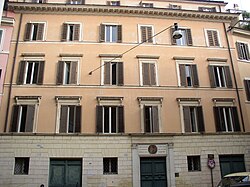Piazza Scanderbeg | |
|---|---|
| City square | |
 Palazzo Skanderbeg in Piazza Scanderbeg | |
| Location | Rome, Italy |
 | |
| Coordinates: 41°54′2.4″N12°29′5.4″E / 41.900667°N 12.484833°E | |


Piazza Scanderbeg is a square in Rome, Italy. It is located on the junction of Vicolo Scanderbeg and Via della Panetteria. It is named after the Albanian national hero Skanderbeg, who once lived in Palazzo Skanderbeg located on the square. [1]
It was inaugurated by Benito Mussolini.